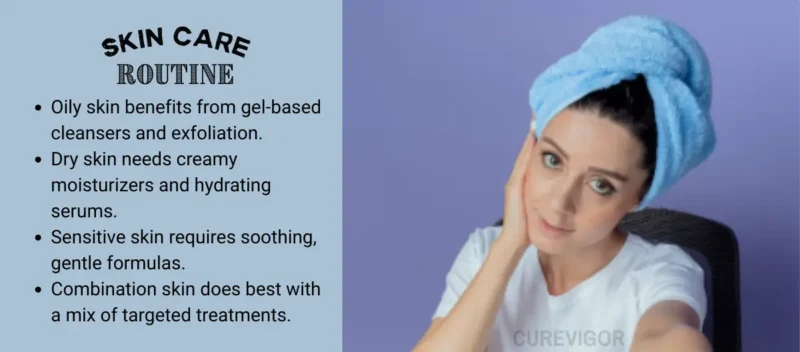Not sure of your skin type? Explore every skin type with tips, charts, and routines to choose the right skincare for a radiant, balanced complexion.
Thank you for reading this post, don't forget to subscribe!Imagine walking into a gym and blindly following the workout plan of an Olympic weightlifter when your goal is to run a marathon. The results would be, at best, inefficient, and at worst, injurious. The same precise logic applies to your skin.
A one-size-fits-all approach is the fastest way to frustration. The absolute, non-negotiable cornerstone of the best skin care routine is a deep, personal understanding of your skin’s unique needs.
It’s like speaking a foreign language when you use products designed for a different skin type; your skin won’t understand, which can confuse, missed connections, and possible negative reactions like irritation, clogged pores, or worsened problems.
Beyond the Basics: Decoding Your Skin’s Unique Language (Type vs. Condition)
Most guidelines stop at the five fundamental skin types. However, to effectively master skincare, you must comprehend a crucial but frequently disregarded distinction: the difference between your skin condition and your skin type.

Skin Type
Your Genetic Blueprint. This is your skin’s fundamental, inherited nature. It’s determined by your genetics, much like your height or eye color. It’s generally stable throughout your life, though it can shift slightly with major hormonal changes (like pregnancy or menopause).
Your type is defined by the amount of oil (sebum) your sebaceous glands naturally produce.
Skin Condition
Your Skin’s Current State. This is a temporary or fluctuating situation that can affect any skin type. Both internal and environmental factors, such as your diet, stress levels, weather conditions, hormonal changes, and the products you use, may affect your condition.
It is possible to have multiple conditions at the same time, such as being dehydrated and prone to acne.
Understanding this difference is revolutionary. It explains why an oily-skinned person can suddenly experience flakiness, or why someone with normally resilient skin can develop redness and sensitivity.
What’s Your Skin Type? Complete Guide to All Skin Types & Skincare Routines
Your skin is the largest organ of your body, and taking care of it properly starts with understanding your skin type. Knowing your skin type—oily, dry, sensitive, or somewhere in between—is essential to developing a skincare regimen that works for you.
Understanding your skin type is crucial for selecting the ideal skincare products and routines to achieve healthy, radiant skin. Without this knowledge, you may end up using the wrong products, causing breakouts, irritation, or dullness instead of achieving balance and radiance.
Determining Your Skin Type
Are you unsure about determining your skin type? The easiest way is to observe how your skin feels and looks throughout the day. Wash your face with a gentle cleanser, leave it bare for a few hours, and then check.
Do you see shine, dryness, redness, or balance? You can also use a skin type quiz or consult a dermatologist for clarity.

Here are the primary skin types and how to care for each one:
1. Normal Skin: The Balanced Ideal
Characteristics: Normal skin is balanced. It’s not too oily and not too dry. Pores are small, breakouts are rare, and the texture feels smooth. Skin looks fresh without much effort.
The Root Cause: A harmonious balance in sebum production and skin cell turnover. The skin barrier is intact and functioning optimally, providing natural protection and hydration.
Key Identifiers:
- A smooth, even texture with minimal concerns and small, barely visible pores.
- No severe sensitivity, excessive shine, or persistent dry patches.
- A radiant, healthy complexion with good elasticity and an overall balanced feel.
Skincare needs: Keep it simple. Use a gentle cleanser, a lightweight moisturizer, and daily sunscreen. Avoid heavy products that might upset the balance. Occasional exfoliation helps maintain a natural glow.
The Goal: To maintain health and prevent future damage. The focus is on consistent, gentle care with antioxidants and daily sun protection to preserve this ideal balance over time. The routine should support the skin’s natural state without overwhelming it.
2. Oily Skin: The Shine of Overproduction
Characteristics: Oily skin looks shiny, especially in the T-zone (forehead, nose, and chin). Pores appear larger and can clog easily. Breakouts, blackheads, and acne are common skin conditions.
The Root Cause: Overactive sebaceous glands are producing an excess of sebum. Acne may have been inherited, hormonal, or triggered by harsh skin-stripping products that cause the skin to overcompensate.
Key Identifiers:
- A persistent shine or greasy feel that appears within an hour or two of cleansing.
- Enlarged, visible pores, particularly on the nose, chin, and forehead (the T-zone).
- A tendency for makeup to “slide off” or appear shiny quickly.
- More likely to get blackheads and whiteheads (comedones) as a result of clogged pores caused by the combination of excess oil and cellular debris.
Skincare needs: Choose oil-control products. To remove excess oil, use a foamy or gel-based cleanser. To protect your skin, use moisturizers without oil and always apply sunscreen. To keep pores clear and reduce acne, exfoliate with salicylic acid two to three times a week.
The Golden Rule & Goal: The objective is balance, not eradication. Stripping the skin with harsh, alcohol-based products signals a crisis to your glands, prompting them to produce even more oil. The goal is to cleanse gently, hydrate with oil-free products, and use ingredients that help regulate sebum production.
3. Dry Skin: The Thirst for Lipids
Characteristics: Dry skin feels tight, rough, or itchy. It often looks flaky and dull, especially after cleansing. Cold weather can make it worse.
The Root Cause: A lack of natural lipids (oils) in the skin. This means the skin’s barrier is compromised and unable to retain moisture effectively.
Key Identifiers:
- a constriction or discomfort, particularly following washing.
- A dull, rough, or ashy appearance, sometimes with visible flakiness.
- Almost invisible pores.
- Fine lines may be more pronounced due to the lack of plumping moisture.
- Can be prone to redness and irritation because a weakened barrier is more vulnerable to external aggressors.
Skincare needs: Focus on hydration. Use creamy, non-stripping cleansers. Apply a rich moisturizer with ceramides, shea butter, or hyaluronic acid. Avoid alcohol-based products and harsh scrubs. Gentle exfoliation, done once a week, helps remove dead skin cells without irritation.
The Goal: Nourish and replenish. The strategy involves using rich, lipid-rich ingredients that mimic the skin’s natural oils (emollients) and create a protective seal to prevent moisture loss (occlusives).
4. Combination Skin: The Tale of Two Zones
Characteristics: Combination skin is tricky. The T-zone is oily, while the cheeks and jawline are dry or normal. It’s a mix of two skin types on one face.
The Root Cause: A mix of overactive sebaceous glands in the T-zone and normal-to-dry oil production elsewhere. This is the most common type of skin.
Key Identifiers:
- An oily T-zone (shine, enlarged pores) juxtaposed with normal or dry cheeks.
- You might find yourself blotting your forehead and nose while your cheeks feel perfectly comfortable or even tight.
Skincare needs: Balance is key. To prevent stripping the skin, use a mild cleanser. Use mild moisturizers that provide moisture without causing oil buildup. For targeted care, use mattifying products on the T-zone and nourishing creams on dry areas. Multi-masking—different masks for different zones—works well.
The Goal: Balance through zoning. This often requires a nuanced approach. You might use a gentle cleanser overall, but apply a lightweight, oil-free moisturizer only to the T-zone and a richer cream to the drier areas of your face.
5. Sensitive Skin: The Reactive Realm
Characteristics: Sensitive skin reacts easily. It may sting, burn, or turn red after using new products. Fragrance, alcohol, or harsh weather can trigger flare-ups.
The Root Cause: A weakened or easily compromised skin barrier, which allows irritants to penetrate more easily and triggers inflammation. It can be genetic or acquired through excessive exfoliation or the use of harsh products.
Key Identifiers:
- Reacts to products with redness, itching, burning, or stinging.
- Prone to redness and visible capillaries (rosacea can be a related concern).
- It can feel tight and uncomfortable.
- Often goes hand-in-hand with dryness.
Skincare needs: Less is more. Stick to fragrance-free, hypoallergenic products. Utilize calming substances like chamomile or aloe vera. Always patch test new products on a small area first. Avoid scrubbing and limit exfoliation to very gentle options.
The Goal: Soothe, strengthen, and simplify. The focus is on fragrance-free, minimal-ingredient formulas that contain calming agents to reduce inflammation and barrier-repairing ingredients to build resilience over time.
6. Acne-Prone Skin: Navigating Inflammation and Clogged Pores
Characteristics: Individuals with acne-prone skin often experience frequent breakouts. Pores clog easily, leading to blackheads, whiteheads, or inflamed pimples. Although usually oily, even dry skin types can be prone to acne.
The Root Cause: A complex condition primarily driven by excess oil production, a buildup of dead skin cells that clog pores, bacterial overgrowth (c. acnes), and inflammation. It can be genetic, hormonal, or triggered by certain products.
Key Identifiers:
- The presence of recurring blemishes such as blackheads, whiteheads, papules (red bumps), and pustules (pus-filled pimples).
- It can vary from minor, sporadic pimples to severe, cystic acne that lies beneath the skin’s surface.
- Often experiences post-inflammatory hyperpigmentation (dark spots that remain after a blemish heals).
- It frequently, but not always, occurs alongside oily skin and enlarged pores.
Skincare needs: Use acne-fighting ingredients like salicylic acid, benzoyl peroxide, or niacinamide. Choose lightweight, non-comedogenic moisturizers. Avoid heavy oils and harsh scrubs, as they can exacerbate irritation. Consistency is key—stick to a routine to keep breakouts under control.
The Goal: Manage breakouts by unclogging pores, reducing bacteria, and calming inflammation, all while supporting a healthy skin barrier to prevent further irritation. The focus is on consistent, targeted treatment without over-drying the skin.
Understanding Skin Type and Skincare
A. Importance of Skin Type
Your skin type serves as a compass guiding your skincare choices. When you know whether your skin is oily, dry, sensitive, or acne-prone, you can pick products that actually work for you. This reduces the risk of irritation, breakouts, or wasted money on products that don’t suit your needs.
B. Skincare Routine
Building a skincare routine around your skin type means addressing your unique concerns while maintaining a balanced complexion. For example:
- Oily skin benefits from gel-based cleansers and exfoliation.
- Dry skin needs creamy moisturizers and hydrating serums.
- Sensitive skin requires soothing, gentle formulas.
- Combination skin does best with a mix of targeted treatments.
No matter your skin type, every routine should include cleansing, moisturizing, and sun protection.
Skincare Routine by Skin Type
- Normal Skin
- Wash with a gentle, pH-balanced cleanser morning and night.
- Use a light, water-based moisturizer to maintain balance.
- Apply a broad-spectrum SPF 30+ every morning.
- Add vitamin C serum to boost natural glow.
- Exfoliate your skin once a week to maintain its smoothness.
- Oily Skin
- Cleanse twice daily with a foaming or gel cleanser to cut shine.
- Use oil-free, non-comedogenic moisturizers to hydrate without clogging.
- Apply a clay mask once a week to absorb excess oil.
- Exfoliate with salicylic acid 2–3 times a week to prevent breakouts.
- Always wear a mattifying sunscreen to control grease.
- Dry Skin
- Use a creamy, hydrating cleanser that won’t strip your skin’s natural oils.
- Apply a thick moisturizer with ceramides or shea butter.
- Layer hydrating serums with hyaluronic acid under cream.
- Protect your skin with a nourishing SPF lotion every day.
- Sleep in an overnight mask for deep hydration.
- Combination Skin
- Wash with a balancing cleanser that isn’t too harsh.
- Apply a lightweight gel moisturizer across the face.
- Use mattifying products only on the oily T-zone.
- Nourish dry areas with thicker creams as needed.
- Try multi-masking—use a clay mask for oily zones and a hydrating mask for dry zones.
- Sensitive Skin
- Choose a fragrance-free, hypoallergenic cleanser.
- Hydrate with soothing ingredients like aloe or oat extract.
- Avoid alcohol-based toners and harsh exfoliants.
- Before using a new product completely, test it first.
- Apply a mineral sunscreen that contains titanium dioxide or zinc oxide.
- Acne-Prone Skin
- Cleanse with salicylic acid or benzoyl peroxide daily to help remove impurities.
- Use lightweight, oil-free moisturizers to prevent dryness.
- Apply spot treatments directly on active pimples.
- Avoid thick creams that clog pores.
- Protect your skin with non-comedogenic SPF to reduce the risk of scarring.
Skin Type Chart
| Skin Type | Key Characteristics | Skincare Needs |
|---|---|---|
| Normal Skin | Balanced oil and hydration, smooth texture, small pores, few breakouts | Gentle cleanser, light moisturizer, antioxidants, SPF |
| Oily Skin | Shiny (especially T-zone), large pores, prone to acne, frequent breakouts | Oil-control cleanser, salicylic acid exfoliant, oil-free moisturizer, SPF |
| Dry Skin | Tight, flaky, dull, easily irritated, small pores, low oil production | Hydrating cleanser, rich moisturizer, hyaluronic acid, overnight masks, SPF lotion |
| Combination Skin | Oily T-zone + dry cheeks, mixed pore sizes, both shine and dryness | Balancing cleanser, gel moisturizer, multi-masking, targeted products |
| Sensitive Skin | Easily irritated, redness, stinging, burning, triggered by fragrance or harsh products | Fragrance-free, soothing ingredients, patch testing, mineral SPF |
| Acne-Prone Skin | Balanced oil and hydration, smooth texture, small pores, and few breakouts | Frequent breakouts, blackheads, whiteheads, and inflamed or clogged pores |
FAQs
Q. How do I determine my skin type at home?
Wash your face with a mild cleanser and let it sit bare for two hours to find out your skin type. If your skin feels tight, it is likely dry. If you notice shine, especially in the T-zone, your skin is oily.
If both happen—oily in some areas and dry in others—you have combination skin. If your skin stays balanced and comfortable, it’s normal. Redness or stinging may indicate sensitive skin.
Q. Can skin type change over time?
Yes, your skin type can change. Hormonal shifts, age, stress, diet, and climate can all affect your skin. For example, many people with oily skin in their teens may develop combination or dry skin as they get older. Tracking changes helps you adjust your skincare routine before problems appear.
Q. What skincare routine works for every skin type?
Every skin type benefits from three basic steps:
- Use a mild face cleanser to wash away oil and debris from your face.
- Moisturize to keep skin hydrated and balanced.
- Protect with SPF 30+ daily to prevent sun damage and premature aging.
- After establishing this foundation, you can add targeted treatments—such as salicylic acid for acne-prone skin or rich creams for dry skin.
Q. Which skin type is most prone to acne?
Oily and acne-prone skin types are most likely to experience breakouts because excess oil can clog pores, leading to inflammation and blemishes. However, even dry or sensitive skin can develop acne due to irritation, hormonal changes, or the use of incorrect products. The best approach is to use non-comedogenic skincare products and active ingredients, such as benzoyl peroxide or salicylic acid.
Q. Is sensitive skin the same as allergic skin?
No, sensitive skin and allergic skin are different. Sensitive skin reacts easily to heat, fragrance, or harsh chemicals, often with redness or stinging. Allergic reactions, on the other hand, involve the immune system and may cause swelling, rashes, or hives. If you suspect allergies, consult a dermatologist for patch testing to confirm the diagnosis.
Conclusion
Understanding your skin type is the first step toward achieving healthy, glowing skin. From normal to oily, dry to sensitive, and combination to acne-prone, each skin type has distinct characteristics and specific care needs.
You may steer clear of common skin issues and enhance the appearance of your complexion by customizing your skincare regimen to your skin’s natural characteristics.
If you’re unsure, use a skin type chart or take a skin type quiz—and remember, your skin may change over time due to age, hormones, or climate.
Final thought: The better you know your skin, the easier it becomes to choose the right products and enjoy clear, balanced, and radiant skin every day.
Get more Health & Beauty Tips.
You might love:

